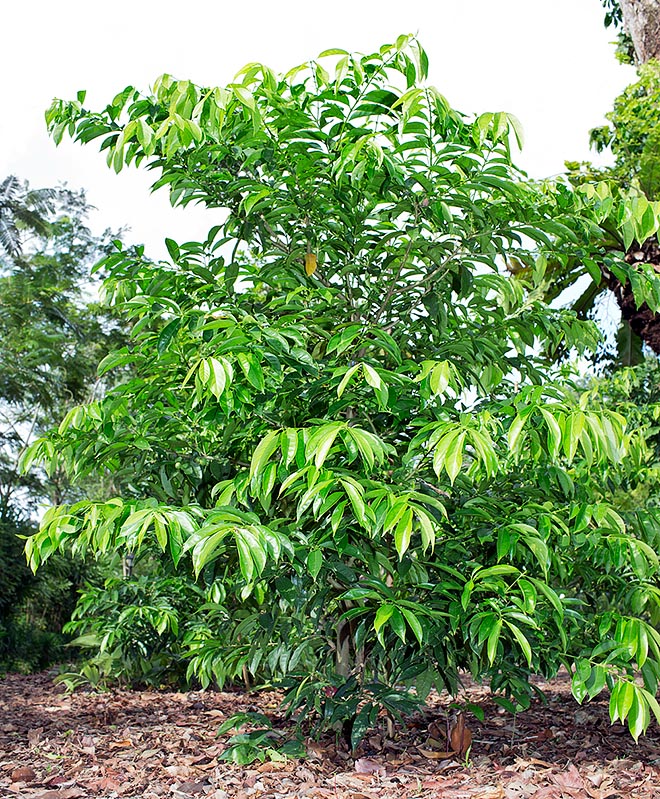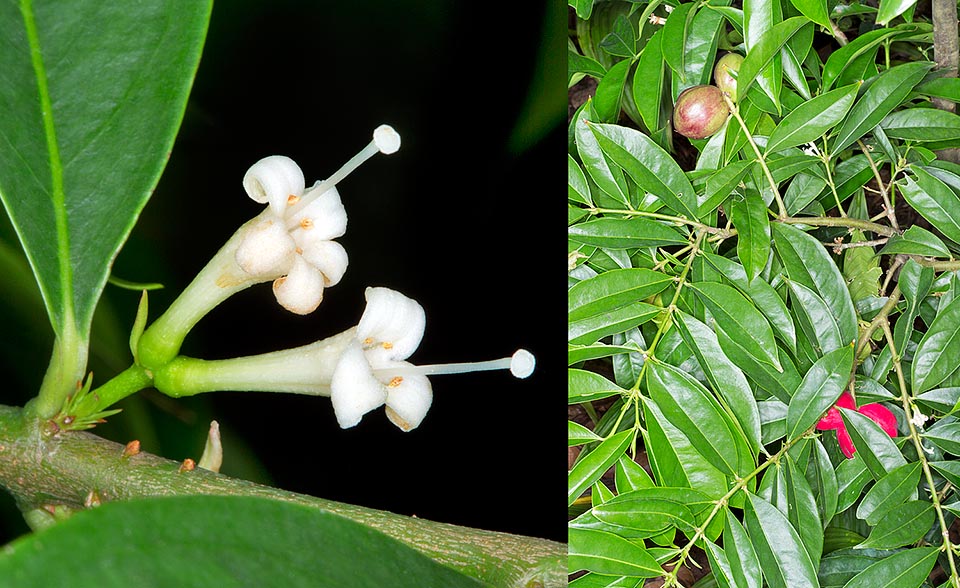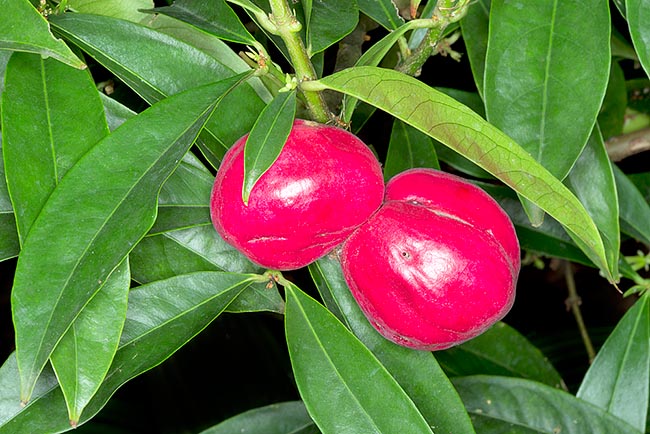Family : Thymelaeaceae

Text © Pietro Puccio

English translation by Mario Beltramini

Phaleria macrocarpa is a New Guinea evergreen that may be 18 m tall © Giuseppe Mazza
The species is native to New Guinea, where it grows in the primary and secondary forests from the sea level up to about 1000 m of altitude.
The generic name comes from the Greek “φαληρος” (phaleros) = bright white, with reference to the flowers; the specific name is the combination of the Greek adjective “μακρός” (macrόs) = big and of the substantive “καρπός” (carpόs) = fruit, with obvious reference.
Common names: God’s crown (English); mahkota dewa, makuto dewo, makuto ratu, raja obat (Java); simalakama (Sumatra).
The Phaleria macrocarpa (Scheff.) Boerl. (1900) is a shrub or an evergreen tree, that in the old specimens in the wild may reach the height of about 18 m, but that in cultivation keeps much lower, usually not exceeding the 5 m, with erect trunk, cylindrical, up to about 15 cm of diameter, with smooth or slightly wrinkled brownish bark and dense crown.
The leaves, on a 0,5 cm long petiole, are opposite, simple, elliptic to oblong-lanceolate with pointed apex, 7-14 cm long and 3-5 cm broad, coriaceous, of dark green colour.
Umbelliform inflorescences, on a 0,3-2 cm long peduncle, directly on the branches (cauliflory) or at the axil of the leaves, carrying 2-5 white sessile flowers, fragrant, funnel shaped, 1,5-3,5 cm long, formed by the only calyx with retroflexed lobes, about 0,5 cm long, and 5 prominent stamina.
Globose fruits of 3-6 cm of diameter initially green, then dark red when ripe, containing 1-2 sub-globose seeds, of about 1,5 cm of diameter, of brown colour immersed in white fibrous pulp.

The bright white of the small flowers has originated the scientific name of the genus. The globose, 3-6 cm fruits are initially green, then dark red when ripe © G. Mazza
It reproduces by seed, that germinates easily if fresh, in organic draining loam maintained humid at the temperature of 25-28 °C. Species cultivable exclusively in the tropical and humid subtropical climate regions, in full sun or partial shade, on draining soils, slightly acidic to slightly alkaline.

All parts of the plant are highly poisonous, particularly fruits and seeds, but promising medicinal virtues © Mazza
In the lesser favourable climates it may be cultivated in pot, in organic loam with addition of siliceous sand or agri-perlite per a 30%, to be sheltered in luminous ambient with lowest night winter temperatures not under the 16 °C. Regular waterings during the vegetative period, more reduced in winter, but without ever allowing the loam to dry up completely, and fertilizations in spring-summer with a hydrosoluble product with microelements.
All parts of the plant are highly poisonous, in particular fruits and seeds, and cannot be taken directly; laboratory studies have evidenced the presence in the leaves and in the fruits of various bioactive compounds, alkaloids, flavonoids, polyphenols and saponins, of possible interest in the official pharma- copoeia. Since remote times it is one of the most popular plants of the Indonesian traditional medicine, in particular in the empirical treatment of cancer and diabetes, where are variously used and duly treated, due to their toxicity, the leaves and the various parts of the fruit. It has also a limited employment as shade and ornamental tree, even if its positioning must be carefully evaluated due to the attractive, but particularly toxic, fruits.
Synonyms: Phaleria papuana Warb. ex K. Schum. & Lauterb. (1901); Phaleria calantha Gilg (1910); Phaleria wichmannii Valeton (1913); Phaleria papuana var. wichmannii (Valeton) Backer (1942).
→ To appreciate the biodiversity within the THYMELAEACEAE family please click here.
